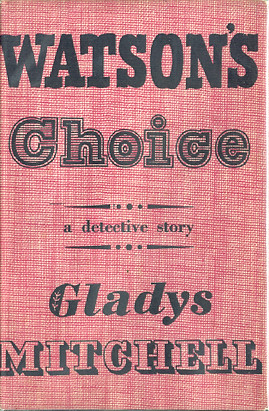WATSON'S CHOICE (1955)
1955 Michael Joseph. Reprinted 1957 Penguin paperback; 1975 Magna Large Print; 1976 McKay Washburn (U.S.); 1981 Dell paperback (U.S.); 1985 Michael Joseph book club reissue; 2017 Vintage Press.
"Well, now," [Mrs. Bradley] said, "to explain my business here. You have read in the newspapers, I take it, that the dead body of a young woman has been found on a deserted railway station not so very far from this house."
"I did not read of it myself--I don't read the newspapers--but Miss Galbraith has been full of it. Not our best type, I'm afraid. In fact--difficult. Very difficult. She has been on the stage, and she finds it hard to settle to the kind of life we lead here. If it had not been for Reverend Snaith, who happens to be very sorry for her, I would have preferred not to take her. She is not very manageable, I'm afraid."
Mrs. Bradley had begun to be fascinated by the numbers of things of which the matron appeared to be afraid.

Sir Bohun Chantrey lays plans for a rather elaborate theme party, centered around the Conan Doyle Sherlock Holmes tales. The fastidious host even assigns each of his guests a particular role from the stories, though this does not deter people from following their own inspirations. (Mrs. Bradley opts for the guise of Mrs. Farintosh, a minor character referenced in The Speckled Band.) Sir Bohun's luck holds when the country house is beset by atmospheric fog on the night of the party, but a scavenger hunt showcasing objects from the various Holmes stories reveals a few unforeseen clues: Mrs. Bradley's secretary, Laura Menzies, discovers a bottle of laudanum on a bathroom sill that was never intended for the game; and rooms that were once open are now marked as out-of-bounds to scavenger hunters. The evening peaks with the dramatic appearance of a phosphorescent Hound of the Baskervilles, a sight that frightens Sir Bohun's fiancee Linda Campbell nearly to death.
After the party, tensions strain between Sir Bohun and Miss Campbell, who are observed bickering more often than not; the relationship between Sir Bohun and his illegitimate son, bullfighter Manoel Lupez, is just as stormy. When Linda Campbell disappears, the house tutor tells anyone who will listen about his prophetic dream of finding the woman dead out on the heath. Miss Campbell returns, however, with a strange story about being abducted and locked in a room before being released. Her second disappearance ends more tragically, though equally mysteriously: her body is found in an abandoned train station building, the same one used to house the oversize hound. Mrs. Bradley investigates, and, with the help of Laura and "musketeer" Alice Boorman (here married to a farmer, and with a son!), does her best to unravel the tangled skein.
Leave it to Gladys Mitchell and her unpredictable plotlines to confound reader expectations. I began Watson's Choice expecting to find a tale of murder during a country house party; I was plumping for wealthy, disagreeable Sir Bohun Chantrey as obligatory victim. I was wrong on both counts. Though Watson's story kept me entertained, this Mrs. Bradley mystery (the sleuth's last before adopting the title of Dame for the rest of her career) falls short on the invention and fun of a classic entry. That said (or opined), there's enough to recommend here, especially if you're a Sherlock Holmes fan and know your way around the canon.
The various characters -- including a vaudeville actor, a bullfighter, and a divorce-nearing couple -- are introduced in the first chapter in a time-honored way: they each receive, and react to, an invitation to Sir Bohun's house party. Although it works well here, interestingly, Gladys Mitchell rarely used such a traditional opening (i.e., meeting the future suspects, one by one), preferring instead to tell a story through a single narrator, or from the vantage point of her capable detective. Sometimes her structure is singularly quirky: in Merlin's Furlong, Chapter One follows a fractious family from whom we don't hear again until a trio of new characters stumbles upon the patriarch's body midway through the book. Such unpredictability of structure -- combined, I would add, with the merits of varying her narrative tones and styles so that each book carries its own voice -- often keeps the seasoned mystery reader, always on the lookout to guess in advance which way the plotline tilts, delightfully off balance.
The objects to be discovered by the scavenger hunters at the Conan Doyle party are referential and at times obscure: "Francis H. Moulton's hotel bill -- The Noble Bachelor;" "Stable-lad Hunter's opium-drugged curry -- The Silver Blaze." The Hound of the Baskervilles figures prominently, and the killer's undoing is tied up with The Six Napoleons. Sir Bohun naturally employs a red-headed secretary, and some nice Mitchell humour springs from the squire's exasperation as his guests switch costumes with one another and wander away from the party's according-to-Doyle specifics. It is obvious that Gladys Mitchell both enjoys and admires the Sherlock Holmes stories, and they serve reasonably well as inspiration for her. Watson's Choice is the most readily obtainable Mrs. Bradley title owing to its many reprintings, and quite likely the only one that non-Mitchell fans (but Holmes enthusiasts) may collect. First-time Mitchell readers could form a lesser introduction through other books (the slight, unsatisfying Faintley Speaking, also reprinted in the U.S., comes to mind) but there are also many more memorable titles from which to start.
And yes, that text-and-crosshatch jacket is a scan of the original first edition cover. Reprint jackets are similarly lacking: the book club edition features a straightforward sketch of a slightly startled (and seemingly Rathbone/Bruce inspired) Holmes and Watson; the Dell paperback sports a puzzle piece. I daresay Watson would have chosen more inspired cover designs...